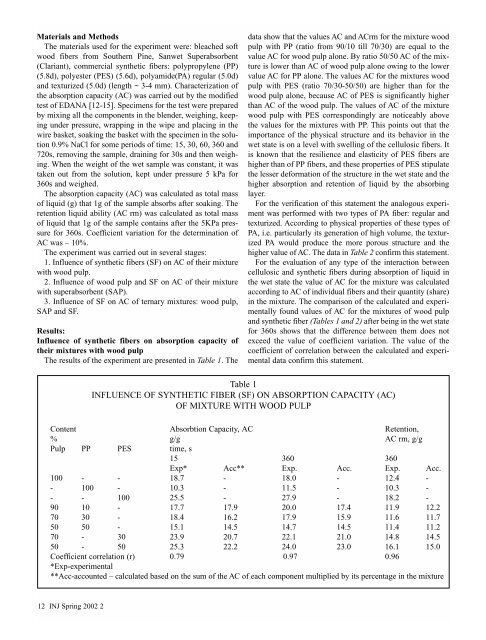2002 - Volume 1 - JEFF. Journal of Engineered Fibers and Fabrics
2002 - Volume 1 - JEFF. Journal of Engineered Fibers and Fabrics
2002 - Volume 1 - JEFF. Journal of Engineered Fibers and Fabrics
You also want an ePaper? Increase the reach of your titles
YUMPU automatically turns print PDFs into web optimized ePapers that Google loves.
Materials <strong>and</strong> Methods<br />
The materials used for the experiment were: bleached s<strong>of</strong>t<br />
wood fibers from Southern Pine, Sanwet Superabsorbent<br />
(Clariant), commercial synthetic fibers: polypropylene (PP)<br />
(5.8d), polyester (PES) (5.6d), polyamide(PA) regular (5.0d)<br />
<strong>and</strong> texturized (5.0d) (length ~ 3-4 mm). Characterization <strong>of</strong><br />
the absorption capacity (AC) was carried out by the modified<br />
test <strong>of</strong> EDANA [12-15]. Specimens for the test were prepared<br />
by mixing all the components in the blender, weighing, keeping<br />
under pressure, wrapping in the wipe <strong>and</strong> placing in the<br />
wire basket, soaking the basket with the specimen in the solution<br />
0.9% NaCl for some periods <strong>of</strong> time: 15, 30, 60, 360 <strong>and</strong><br />
720s, removing the sample, draining for 30s <strong>and</strong> then weighing.<br />
When the weight <strong>of</strong> the wet sample was constant, it was<br />
taken out from the solution, kept under pressure 5 kPa for<br />
360s <strong>and</strong> weighed.<br />
The absorption capacity (AC) was calculated as total mass<br />
<strong>of</strong> liquid (g) that 1g <strong>of</strong> the sample absorbs after soaking. The<br />
retention liquid ability (AC rm) was calculated as total mass<br />
<strong>of</strong> liquid that 1g <strong>of</strong> the sample contains after the 5KPa pressure<br />
for 360s. Coefficient variation for the determination <strong>of</strong><br />
AC was – 10%.<br />
The experiment was carried out in several stages:<br />
1. Influence <strong>of</strong> synthetic fibers (SF) on AC <strong>of</strong> their mixture<br />
with wood pulp.<br />
2. Influence <strong>of</strong> wood pulp <strong>and</strong> SF on AC <strong>of</strong> their mixture<br />
with superabsorbent (SAP).<br />
3. Influence <strong>of</strong> SF on AC <strong>of</strong> ternary mixtures: wood pulp,<br />
SAP <strong>and</strong> SF.<br />
Results:<br />
Influence <strong>of</strong> synthetic fibers on absorption capacity <strong>of</strong><br />
their mixtures with wood pulp<br />
The results <strong>of</strong> the experiment are presented in Table 1. The<br />
12 INJ Spring <strong>2002</strong> 2<br />
data show that the values AC <strong>and</strong> ACrm for the mixture wood<br />
pulp with PP (ratio from 90/10 till 70/30) are equal to the<br />
value AC for wood pulp alone. By ratio 50/50 AC <strong>of</strong> the mixture<br />
is lower than AC <strong>of</strong> wood pulp alone owing to the lower<br />
value AC for PP alone. The values AC for the mixtures wood<br />
pulp with PES (ratio 70/30-50/50) are higher than for the<br />
wood pulp alone, because AC <strong>of</strong> PES is significantly higher<br />
than AC <strong>of</strong> the wood pulp. The values <strong>of</strong> AC <strong>of</strong> the mixture<br />
wood pulp with PES correspondingly are noticeably above<br />
the values for the mixtures with PP. This points out that the<br />
importance <strong>of</strong> the physical structure <strong>and</strong> its behavior in the<br />
wet state is on a level with swelling <strong>of</strong> the cellulosic fibers. It<br />
is known that the resilience <strong>and</strong> elasticity <strong>of</strong> PES fibers are<br />
higher than <strong>of</strong> PP fibers, <strong>and</strong> these properties <strong>of</strong> PES stipulate<br />
the lesser deformation <strong>of</strong> the structure in the wet state <strong>and</strong> the<br />
higher absorption <strong>and</strong> retention <strong>of</strong> liquid by the absorbing<br />
layer.<br />
For the verification <strong>of</strong> this statement the analogous experiment<br />
was performed with two types <strong>of</strong> PA fiber: regular <strong>and</strong><br />
texturized. According to physical properties <strong>of</strong> these types <strong>of</strong><br />
PA, i.e. particularly its generation <strong>of</strong> high volume, the texturized<br />
PA would produce the more porous structure <strong>and</strong> the<br />
higher value <strong>of</strong> AC. The data in Table 2 confirm this statement.<br />
For the evaluation <strong>of</strong> any type <strong>of</strong> the interaction between<br />
cellulosic <strong>and</strong> synthetic fibers during absorption <strong>of</strong> liquid in<br />
the wet state the value <strong>of</strong> AC for the mixture was calculated<br />
according to AC <strong>of</strong> individual fibers <strong>and</strong> their quantity (share)<br />
in the mixture. The comparison <strong>of</strong> the calculated <strong>and</strong> experimentally<br />
found values <strong>of</strong> AC for the mixtures <strong>of</strong> wood pulp<br />
<strong>and</strong> synthetic fiber (Tables 1 <strong>and</strong> 2) after being in the wet state<br />
for 360s shows that the difference between them does not<br />
exceed the value <strong>of</strong> coefficient variation. The value <strong>of</strong> the<br />
coefficient <strong>of</strong> correlation between the calculated <strong>and</strong> experimental<br />
data confirm this statement.<br />
Table 1<br />
INFLUENCE OF SYNTHETIC FIBER (SF) ON ABSORPTION CAPACITY (AC)<br />
OF MIXTURE WITH WOOD PULP<br />
Content Absorbtion Capacity, AC Retention,<br />
% g/g AC rm, g/g<br />
Pulp PP PES time, s<br />
15 360 360<br />
Exp* Acc** Exp. Acc. Exp. Acc.<br />
100 - - 18.7 - 18.0 - 12.4 -<br />
- 100 - 10.3 - 11.5 - 10.3 -<br />
- - 100 25.5 - 27.9 - 18.2 -<br />
90 10 - 17.7 17.9 20.0 17.4 11.9 12.2<br />
70 30 - 18.4 16.2 17.9 15.9 11.6 11.7<br />
50 50 - 15.1 14.5 14.7 14.5 11.4 11.2<br />
70 - 30 23.9 20.7 22.1 21.0 14.8 14.5<br />
50 - 50 25.3 22.2 24.0 23.0 16.1 15.0<br />
Coefficient correlation (r) 0.79 0.97 0.96<br />
*Exp-experimental<br />
**Acc-accounted – calculated based on the sum <strong>of</strong> the AC <strong>of</strong> each component multiplied by its percentage in the mixture

















